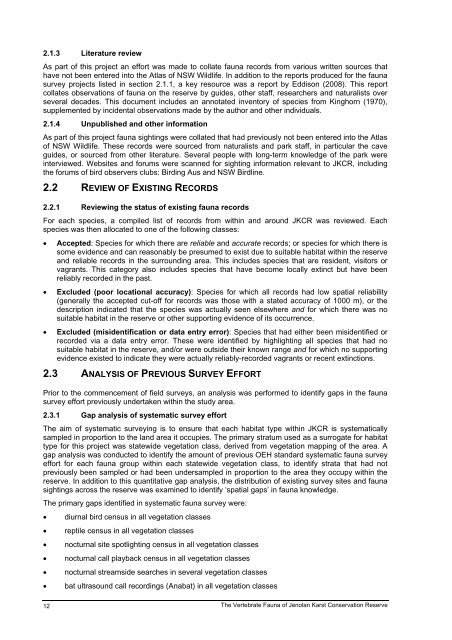The Vertebrate Fauna of Jenolan Karst Conservation Reserve: Final
The Vertebrate Fauna of Jenolan Karst Conservation Reserve: Final
The Vertebrate Fauna of Jenolan Karst Conservation Reserve: Final
Create successful ePaper yourself
Turn your PDF publications into a flip-book with our unique Google optimized e-Paper software.
2.1.3 Literature review<br />
As part <strong>of</strong> this project an effort was made to collate fauna records from various written sources that<br />
have not been entered into the Atlas <strong>of</strong> NSW Wildlife. In addition to the reports produced for the fauna<br />
survey projects listed in section 2.1.1, a key resource was a report by Eddison (2008). This report<br />
collates observations <strong>of</strong> fauna on the reserve by guides, other staff, researchers and naturalists over<br />
several decades. This document includes an annotated inventory <strong>of</strong> species from Kinghorn (1970),<br />
supplemented by incidental observations made by the author and other individuals.<br />
2.1.4 Unpublished and other information<br />
As part <strong>of</strong> this project fauna sightings were collated that had previously not been entered into the Atlas<br />
<strong>of</strong> NSW Wildlife. <strong>The</strong>se records were sourced from naturalists and park staff, in particular the cave<br />
guides, or sourced from other literature. Several people with long-term knowledge <strong>of</strong> the park were<br />
interviewed. Websites and forums were scanned for sighting information relevant to JKCR, including<br />
the forums <strong>of</strong> bird observers clubs: Birding Aus and NSW Birdline.<br />
2.2 REVIEW OF EXISTING RECORDS<br />
2.2.1 Reviewing the status <strong>of</strong> existing fauna records<br />
For each species, a compiled list <strong>of</strong> records from within and around JKCR was reviewed. Each<br />
species was then allocated to one <strong>of</strong> the following classes:<br />
Accepted: Species for which there are reliable and accurate records; or species for which there is<br />
some evidence and can reasonably be presumed to exist due to suitable habitat within the reserve<br />
and reliable records in the surrounding area. This includes species that are resident, visitors or<br />
vagrants. This category also includes species that have become locally extinct but have been<br />
reliably recorded in the past.<br />
Excluded (poor locational accuracy): Species for which all records had low spatial reliability<br />
(generally the accepted cut-<strong>of</strong>f for records was those with a stated accuracy <strong>of</strong> 1000 m), or the<br />
description indicated that the species was actually seen elsewhere and for which there was no<br />
suitable habitat in the reserve or other supporting evidence <strong>of</strong> its occurrence.<br />
Excluded (misidentification or data entry error): Species that had either been misidentified or<br />
recorded via a data entry error. <strong>The</strong>se were identified by highlighting all species that had no<br />
suitable habitat in the reserve, and/or were outside their known range and for which no supporting<br />
evidence existed to indicate they were actually reliably-recorded vagrants or recent extinctions.<br />
2.3 ANALYSIS OF PREVIOUS SURVEY EFFORT<br />
Prior to the commencement <strong>of</strong> field surveys, an analysis was performed to identify gaps in the fauna<br />
survey effort previously undertaken within the study area.<br />
2.3.1 Gap analysis <strong>of</strong> systematic survey effort<br />
<strong>The</strong> aim <strong>of</strong> systematic surveying is to ensure that each habitat type within JKCR is systematically<br />
sampled in proportion to the land area it occupies. <strong>The</strong> primary stratum used as a surrogate for habitat<br />
type for this project was statewide vegetation class, derived from vegetation mapping <strong>of</strong> the area. A<br />
gap analysis was conducted to identify the amount <strong>of</strong> previous OEH standard systematic fauna survey<br />
effort for each fauna group within each statewide vegetation class, to identify strata that had not<br />
previously been sampled or had been undersampled in proportion to the area they occupy within the<br />
reserve. In addition to this quantitative gap analysis, the distribution <strong>of</strong> existing survey sites and fauna<br />
sightings across the reserve was examined to identify ‘spatial gaps’ in fauna knowledge.<br />
<strong>The</strong> primary gaps identified in systematic fauna survey were:<br />
diurnal bird census in all vegetation classes<br />
reptile census in all vegetation classes<br />
nocturnal site spotlighting census in all vegetation classes<br />
nocturnal call playback census in all vegetation classes<br />
nocturnal streamside searches in several vegetation classes<br />
bat ultrasound call recordings (Anabat) in all vegetation classes<br />
12<br />
<strong>The</strong> <strong>Vertebrate</strong> <strong>Fauna</strong> <strong>of</strong> <strong>Jenolan</strong> <strong>Karst</strong> <strong>Conservation</strong> <strong>Reserve</strong>

















